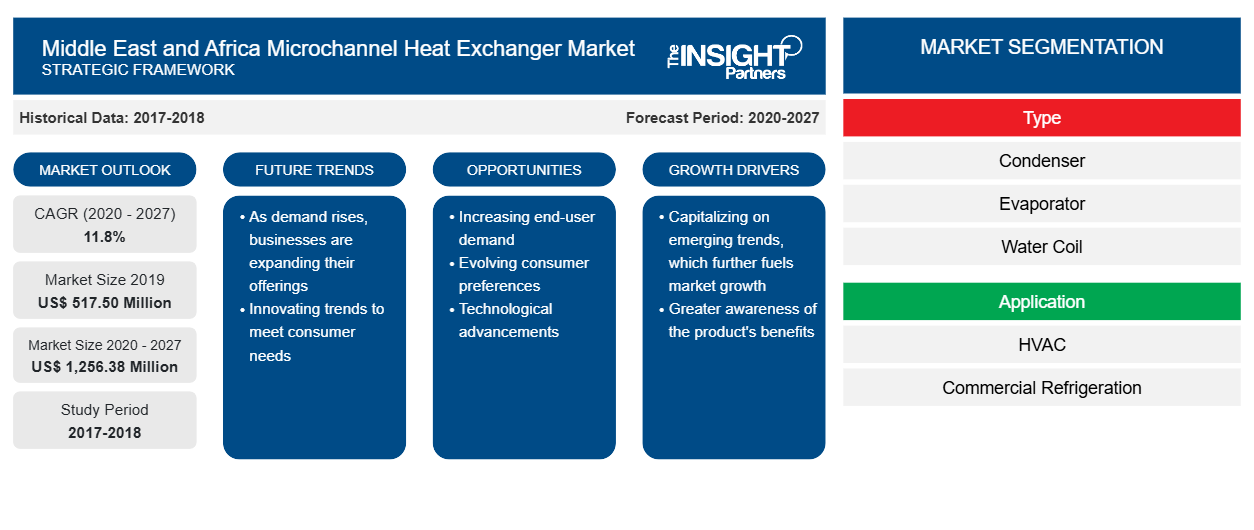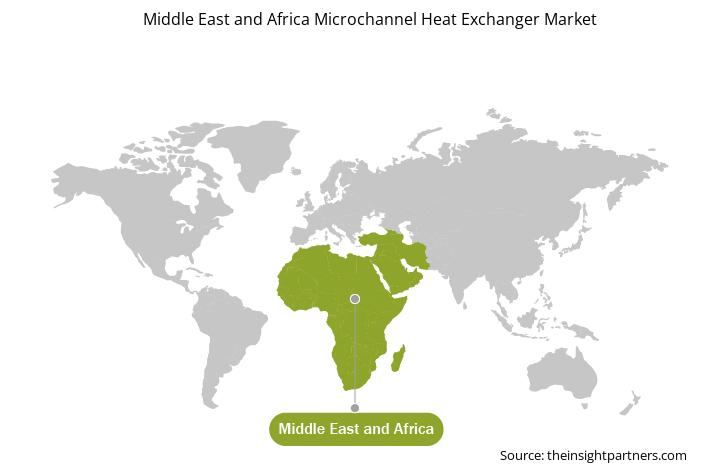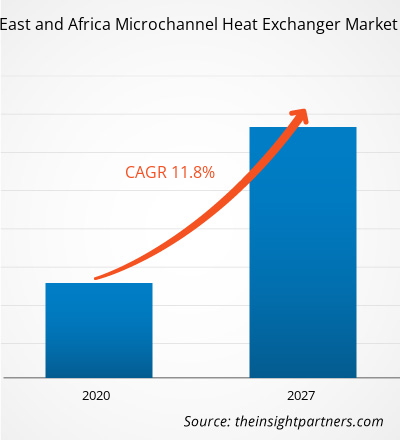The Middle East and Africa microchannel heat exchanger market was valued at US$ 517.50 million in 2019 and is projected to reach US$ 1,256.38 million by 2027; it is expected to grow at a CAGR of 11.8% during 2020–2027.
Micro heat exchangers or microstructured heat exchangers are heat exchangers in which the fluid flows in lateral confinements with dimensions below 1 mm. A microchannel heat exchanger is a heat exchanger with a hydraulic diameter below 1 mm. It can be made using ceramic or metal. The microchannel heat exchanger is used in applications such as heat pumps, air conditioning, and high performance aircraft gas turbine engines. Microchannel heat exchangers find applications in various essential and diverse fields, including aerospace, bioengineering, gas turbine blade cooling, power and process industries, refrigeration and air conditioning; infrared detectors, and efficient laser mirrors and superconductors, microelectronics; and film deposition thermal control. The advantages offered by microchannel heat exchangers include high volumetric heat flux, compactness for space-critical applications, robust design, efficient flow distribution, and moderate pressure drops.
The COVID-19 pandemic first began in Wuhan, China, during December 2019, and since then it has spread across the world at a fast pace. The US, India, Brazil, Russia, Spain, Argentina, and France are among the most affected countries in terms of confirmed cases and reported deaths as of October 2020. According to the latest WHO figures as of October 2020, there are ~40,251,950 confirmed cases and 1,116,131 total deaths globally. COVID-19 has affected economies and industries in various countries due to lockdowns, travel bans, and business shutdowns. North American chemical and materials industry is one of the major industries suffering serious disruptions, such as supply chain breaks and interruptions in manufacturing, due to COVID-19 outbreak. The lockdown of various plants and factories in South Africa as well as leading regions such as Asia Pacific and Europe is affecting the global supply chains and negatively impacting the manufacturing, delivery schedules, and sales of various goods. All these factors have greatly affected the Middle East and Africa microchannel heat exchanger market
Middle East and Africa Microchannel Heat Exchanger Market
- This FREE sample will include data analysis, ranging from market trends to estimates and forecasts.
Market Insights
Steady Growth in Automotive Production
In automotive applications, heat exchangers are used for transferring heat from hot exhaust gas to the coolant fluid to increase the temperature of the coolant. Furthermore, the ability to efficiently transfer heat between fluids using lightweight, compact heat exchangers is important in a variety of applications, such as automotive radiators, air conditioning, and aerospace applications. Microchannel heat exchangers are well suited to these applications due to the compactness, lightness, and high heat transfer performance of the microchannel. MCHE is a well-proven technology, which has been widely used in the automotive industry for 20 years due to its efficiency, economy, recyclability, and lightness. Microchannel aluminum heat exchangers are used in the automotive industry due to their energy efficiency. Heat exchanger manufacturing companies are investing heavily in R&D to develop energy-efficient heat exchangers. Vendors are actively researching the use of thermoelectric technology for the recovery of lost heat energy. Research is ongoing on the TE waste heat energy recovery method for the application of internal combustion engines in the automotive sector. A TEG framework for automotive waste heat recovery systems would also be implemented. The use of the automotive plate-fin heat exchanger and TEG would enhance heat transfer. For example, Climetal has introduced advanced microchannel aluminum heat exchangers for HVAC systems in automotive and other commercial systems. The close spacing and small channel diameter of the microchannel aluminum heat exchangers lead to the development of a heat exchanger with very high energy efficiency and a very low refrigerant charge. Thus, by improving the design of the heat exchanger, it is able to offer improved energy efficiency and savings in terms of operating costs. Developments in the automotive heat exchanger technology are expected to increase the use of automotive heat exchangers in automotive vehicles.
Type Based Insights
Based on type, the microchannel heat exchanger market is segmented into condenser, evaporator and water coil. The condenser segment led the microchannel heat exchanger market with the highest market share in 2019. A condenser is a part of a cooling system (water cooled or air cooled), which is used to remove heat produced by an industrial or commercial process. In condenser coils, the lower header acts as a liquid refrigerant receiver. Construction of the header in this way decreases crucial refrigerant charge problems and optimizes the output of the condenser coil during part load operation. The condenser is the physical state of the heat exchange fluid in which the hot fluid remains at a constant temperature throughout its passage through the heat exchanger, while the temperature of the other fluid (coolant) steadily increases from inlet to outlet. Microchannel condensers are high-performance exchangers. They allow higher global heat transfer coefficients, despite their reduced dimensions. The condenser segment accounted for a significant market share due to the high demand from air conditioner systems for automotive, residential, and commercial sectors. The high demand for condensers in the microchannel heat exchanger is because of the rise in demand from the heat, ventilation, air conditioning (HVAC) industry owing to its compact nature, fewer refrigerant requirements, and high heat transfer rates.
Middle East and Africa Microchannel Heat Exchanger Market, by Type – 2019 and 2027
- This FREE sample will include data analysis, ranging from market trends to estimates and forecasts.
Application Based Market Insights
Based on application, the microchannel heat exchanger market is segmented into HVAC, commercial refrigeration, and others. The others segment led the microchannel heat exchanger market with the highest market share in 2019. The advantages provided by the microchannel heat exchangers include high volumetric heat flux, compactness for space-critical applications, robust design, efficient flow distribution, and moderate pressure drops. Due to these advantages, it is highly preferred in various applications. Honeywell Aerospace has been designing microchannel heat exchangers for aerospace applications. These heat exchangers deliver a substantial reduction in volume and weight reduction compared to state-of-the-art aerospace heat exchangers constructed using offset plate and fin interrupted surfaces.
Customize This Report To Suit Your Requirement
You will get customization on any report - free of charge - including parts of this report, or country-level analysis, Excel Data pack, as well as avail great offers and discounts for start-ups & universities
Middle East and Africa Microchannel Heat Exchanger Market: Strategic Insights

- Get Top Key Market Trends of this report.This FREE sample will include data analysis, ranging from market trends to estimates and forecasts.
You will get customization on any report - free of charge - including parts of this report, or country-level analysis, Excel Data pack, as well as avail great offers and discounts for start-ups & universities
Middle East and Africa Microchannel Heat Exchanger Market: Strategic Insights

- Get Top Key Market Trends of this report.This FREE sample will include data analysis, ranging from market trends to estimates and forecasts.
Product development, merger and acquisition, and business planning are the commonly adopted strategies by companies to expand their product portfolio. Hanon Systems, The Sanhua Holding Group, MAHLE GmbH are amongst the market players implementing this strategy to enlarge the customer base and gain significant market share in Middle East and Africa, which in turn permits them maintain their brand name in the Middle East and Africa market.
Report Spotlights
- Progressive industry trends in the Middle East and Africa microchannel heat exchanger market that help players develop effective long-term strategies
- Business growth strategies adopted by developed and developing markets
- Quantitative analysis of the Middle East and Africa microchannel heat exchanger market from 2017 to 2027
- Estimation of Middle East and Africa microchannel heat exchanger demand across various industries
- PEST analysis to illustrate the efficacy of buyers and suppliers operating in the industry to predict market growth
- Recent developments to understand the market competition in Middle East and Africa
- Market trends and outlook, coupled with factors driving and restraining the growth of the Middle East and Africa microchannel heat exchanger market
- Decision-making process by understanding strategies that underpin commercial interest with regard to the Middle East and Africa microchannel heat exchanger market growth
- Middle East and Africa microchannel heat exchanger market size at various nodes of market
- Detailed overview and segmentation of the Middle East and Africa microchannel heat exchanger market, as well as its dynamics in the industry
- Middle East and Africa microchannel heat exchanger market size in various regions with promising growth opportunities
Middle East and Africa Microchannel Heat Exchanger Market, by Type
- Condenser
- Evaporator
- Water Coil
Middle East and Africa Microchannel Heat Exchanger Market, by Application
- HVAC
- Commercial Refrigeration
- Others
Company Profiles
- API Heat Transfer Inc.
- Climetal S.L
- Danfoss
- DENSO Corporation
- Hanon Systems
- Kaltra
- Zhejiang Kangsheng Co. Ltd (Kasun)
- MAHLE GmbH
- Modine Manufacturing Company
- Sanhua Holding Group Co., Ltd
Middle East and Africa Microchannel Heat Exchanger Market Regional Insights
The regional trends and factors influencing the Middle East and Africa Microchannel Heat Exchanger Market throughout the forecast period have been thoroughly explained by the analysts at Insight Partners. This section also discusses Middle East and Africa Microchannel Heat Exchanger Market segments and geography across North America, Europe, Asia Pacific, Middle East and Africa, and South and Central America.

- Get the Regional Specific Data for Middle East and Africa Microchannel Heat Exchanger Market
Middle East and Africa Microchannel Heat Exchanger Market Report Scope
| Report Attribute | Details |
|---|---|
| Market size in 2019 | US$ 517.50 Million |
| Market Size by 2027 | US$ 1,256.38 Million |
| Global CAGR (2020 - 2027) | 11.8% |
| Historical Data | 2017-2018 |
| Forecast period | 2020-2027 |
| Segments Covered |
By Type
|
| Regions and Countries Covered | Middle East and Africa
|
| Market leaders and key company profiles |
Middle East and Africa Microchannel Heat Exchanger Market Players Density: Understanding Its Impact on Business Dynamics
The Middle East and Africa Microchannel Heat Exchanger Market is growing rapidly, driven by increasing end-user demand due to factors such as evolving consumer preferences, technological advancements, and greater awareness of the product's benefits. As demand rises, businesses are expanding their offerings, innovating to meet consumer needs, and capitalizing on emerging trends, which further fuels market growth.
Market players density refers to the distribution of firms or companies operating within a particular market or industry. It indicates how many competitors (market players) are present in a given market space relative to its size or total market value.
Major Companies operating in the Middle East and Africa Microchannel Heat Exchanger Market are:
- API Heat Transfer Inc.
- Climetal S.L
- Danfoss
- DENSO Corporation
- Hanon Systems
Disclaimer: The companies listed above are not ranked in any particular order.

- Get the Middle East and Africa Microchannel Heat Exchanger Market top key players overview
- Historical Analysis (2 Years), Base Year, Forecast (7 Years) with CAGR
- PEST and SWOT Analysis
- Market Size Value / Volume - Global, Regional, Country
- Industry and Competitive Landscape
- Excel Dataset
Testimonials
Reason to Buy
- Informed Decision-Making
- Understanding Market Dynamics
- Competitive Analysis
- Identifying Emerging Markets
- Customer Insights
- Market Forecasts
- Risk Mitigation
- Boosting Operational Efficiency
- Strategic Planning
- Investment Justification
- Tracking Industry Innovations
- Aligning with Regulatory Trends
Yes! We provide a free sample of the report, which includes Report Scope (Table of Contents), report structure, and selected insights to help you assess the value of the full report. Please click on the "Download Sample" button or contact us to receive your copy.
Absolutely — analyst assistance is part of the package. You can connect with our analyst post-purchase to clarify report insights, methodology or discuss how the findings apply to your business needs.
Once your order is successfully placed, you will receive a confirmation email along with your invoice.
• For published reports: You’ll receive access to the report within 4–6 working hours via a secured email sent to your email.
• For upcoming reports: Your order will be recorded as a pre-booking. Our team will share the estimated release date and keep you informed of any updates. As soon as the report is published, it will be delivered to your registered email.
We offer customization options to align the report with your specific objectives. Whether you need deeper insights into a particular region, industry segment, competitor analysis, or data cut, our research team can tailor the report accordingly. Please share your requirements with us, and we’ll be happy to provide a customized proposal or scope.
The report is available in either PDF format or as an Excel dataset, depending on the license you choose.
The PDF version provides the full analysis and visuals in a ready-to-read format. The Excel dataset includes all underlying data tables for easy manipulation and further analysis.
Please review the license options at checkout or contact us to confirm which formats are included with your purchase.
Our payment process is fully secure and PCI-DSS compliant.
We use trusted and encrypted payment gateways to ensure that all transactions are protected with industry-standard SSL encryption. Your payment details are never stored on our servers and are handled securely by certified third-party processors.
You can make your purchase with confidence, knowing your personal and financial information is safe with us.
Yes, we do offer special pricing for bulk purchases.
If you're interested in purchasing multiple reports, we’re happy to provide a customized bundle offer or volume-based discount tailored to your needs. Please contact our sales team with the list of reports you’re considering, and we’ll share a personalized quote.
Yes, absolutely.
Our team is available to help you make an informed decision. Whether you have questions about the report’s scope, methodology, customization options, or which license suits you best, we’re here to assist. Please reach out to us at sales@theinsightpartners.com, and one of our representatives will get in touch promptly.
Yes, a billing invoice will be automatically generated and sent to your registered email upon successful completion of your purchase.
If you need the invoice in a specific format or require additional details (such as company name, GST, or VAT information), feel free to contact us, and we’ll be happy to assist.
Yes, certainly.
If you encounter any difficulties accessing or receiving your report, our support team is ready to assist you. Simply reach out to us via email or live chat with your order information, and we’ll ensure the issue is resolved quickly so you can access your report without interruption.















- API Heat Transfer Inc.
- Climetal S.L
- Danfoss
- DENSO Corporation
- Hanon Systems
- Kaltra
- Zhejiang Kangsheng Co. Ltd (Kasun)
- MAHLE GmbH
- Modine Manufacturing Company
- Sanhua Holding Group Co., Ltd






 Get Free Sample For
Get Free Sample For